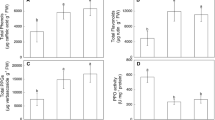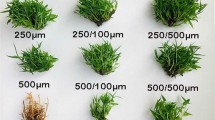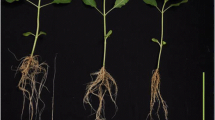Abstract
Ramie (Boehmeria nivea L.) is the oldest cash fiber crop in China and is widely grown in antimony (Sb) mining areas. To evaluate the extent of Sb resistance and tolerance, the growth, tolerance index (TI), Sb content in plant parts and in Hoagland solution, bioaccumulation factor (BF), photosynthesis, and physiological changes in Sb-contaminated B. nivea (20, 40, 80, and 200 mg L−1 Sb) grown hydroponically were investigated. The Sb tolerance and resistance of ramie were clearly revealed by growth inhibition, a TI between 13 and 99 %, non-significant changes in the maximum quantum efficiency of photosystem (F v /F m ), energy-harvesting efficiency (photosystem II (PSII)) and single-photon avalanche diode (SPAD) value, a significant increase in Sb in plant parts, BF >1, and an increase in catalase (CAT) and malondialdehyde (MDA) at 200 mg L−1 Sb. Under increasing Sb stress, nearly the same non-significant decline in the maximum quantum efficiency of photosystem (F v /F m ), energy-harvesting efficiency (PSII), relative quantum yield of photosystem II (φPSII), and photochemical quenching (qP), except for F v /F m at 20 mg L−1 Sb, were recorded. SPAD values for chlorophyll under Sb stress showed an increasing trend, except for a slight decrease, i.e., <2 %, than the control SPAD value at 200 mg L−1 Sb. With a continuous increase in MDA, superoxide dismutase (SOD), peroxidase (POD), and CAT activities were suppressed under Sb addition up to 40 mg L−1 Sb and the addition of Sb enhanced enzyme production at 80 and 200 mg L−1 Sb. A continuous decrease in SOD, POD, and CAT up to 40 mg L−1 Sb and enhancements at ≥80 mg L−1, along with the continuous enhancement of MDA activity and inhibited biomass production, clearly reveal the roles of these enzymes in detoxifying Sb stress and the defense mechanism of ramie at 80 mg L−1 Sb. Thus, B. nivea constitutes a promising candidate for Sb phytoremediation at mining sites.





Similar content being viewed by others
References
Amari T, Ghnaya T, Debez A, Taamali M, Youssef NB, Lucchini G, Sacchi GA, Abdelly C (2014) Comparative Ni tolerance and accumulation potentials between Mesembryanthemum crystallinum (halophyte) and Brassica juncea: metal accumulation, nutrient status and photosynthetic activity. J Plant Physiol 171:1634–1644
Amin H, Arain BA, Amin F, Surhio MA (2014) Analysis of growth response and tolerance index of Glycine max (L.) Merr. under hexavalent chromium stress. Adv Life Sci 1:231–241
Anawar HM, Freitas MC, Canha N, Regina IS (2011) Arsenic, antimony, and other trace element contamination in a mine tailings affected area and uptake by tolerant plant species. Environ Geochem Health 33:353–362
Asmare HA (2013) Impact of salinity on tolerance, vigor, and seedling relative water content of haricot bean (Phaseolus vulgaris L.) cultivars. J Plant Sci 1:22–27
Bahri NB, Laribi B, Soufi S, Rezgui S, Bettaieb T (2015) Growth performance, photosynthetic status and bioaccumulation of heavy metals by Paulownia tomentosa (Thunb.) Steud growing on contaminated soils. Int J Agron Agric Res 6:32–43
Baroni F, Boscagli A, Protano G, Riccoboano F (2000) Antimony accumulation in Achillea ageratum, Plantago lanceolata and Silene vulgaris growing in an old Sb mining area. Environ Pollut 109:347–352
Brennan T, Frenkel C (1977) Involvement of hydrogen peroxide in the regulation of senescence in pear. Plant Physiol 59:411–416
Breusegem FV, Vranova E, Dat JF, Inze D (2001) The role of active oxygen species in plant signal transduction. Plant Sci 161:405–414
Cidu R, Biddau R, Dore E, Vacca A, Marini L (2014) Antimony in the soil–water–plant system at the Su Suergiu abandoned mine (Sardinia, Italy): strategies to mitigate contamination. Sci Total Environ 497–498:319–331
Corrales I, Barceló J, Bech J, Poschenrieder C (2014) Antimony accumulation and toxicity tolerance mechanisms in Trifolium species. J Geochem Explor 147:167–172
Dias MC, Monteiro C, Pereira JM, Correia C, Goncalves B, Santos C (2013) Cadmium toxicity affects photosynthesis and plant growth at different levels. Acta Physiol Plant 35:1281–1289
Dubey RS (1997) Photosynthesis in plants under stressful conditions. In: Pessarakli M (ed) Handbook of photosynthesis. Marcel Dekker, New York, pp 859–975
Efeoğlu B, Ekmekçi Y, Çiçek N (2009) Physiological responses of three maize cultivars to drought stress and recovery. S Afr J Bot 75:34–42
Feng RW, Wei CY (2012) Antioxidative mechanisms on selenium accumulation in Pteris vittata L., a potential selenium phytoremediation plant. Plant Soil Environ 58:105–110
Feng R, Wei C, Tu S, Wu F, Yang L (2009) Antimony accumulation and antioxidative responses in four fern plants. Plant Soil 317:93–101
Feng R, Wei C, Tu S, Tang S, Wu F (2011) Simultaneous hyperaccumulation of arsenic and antimony in Cretan brake fern: evidence of plant uptake and subcellular distributions. Microchem J 97:38–43
Feng RW, Wei CY, Tu SX (2013a) The roles of selenium in protecting plants against abiotic stresses. Environ Exp Bot 87:58–68
Feng RW, Wei CY, Tu SX, Ding YZ, Wang RG, Guo JK (2013b) The uptake and detoxification of antimony by plants: a review. Environ Exp Bot 96:28–34
Feng R, Wang X, Wei C, Tu M (2015) The accumulation and subcellular distribution of arsenic and antimony in four fern plants. Int J Phytoremediation 17:348–354
Filella M, Williams PA (2012) Antimony interactions with heterogeneous complexants in waters, sediments and soils: a review of binding data for homologous compounds. Chem Erde-Geochem 72:49–65
Filella M, Belzile N, Chen YW (2002) Antimony in the environment: a review focused on natural waters. I. Occurrence. Earth-Sci Rev 57:125–176
Filella M, Philippo S, Belzile N, Chen Y, Quentel F (2009a) Natural attenuation processes applying to antimony: a study in the abandoned antimony mine in Goesdorf, Luxembourg. Sci Total Environ 407:6205–6216
Filella M, Williams PA, Belzile N (2009b) Antimony in the environment: knowns and unknowns. Environ Chem 6:95–105
Flagella Z, Campanile RG, Stoppelli MC, Caro AD, Fonzo ND (1998) Drought tolerance of photosynthetic electron transport under CO2-enriched and normal air in cereal species. Physiol Plant 104:753–759
Fu J, Huang B (2001) Involvement of antioxidants and lipid peroxidation in the adaptation of two cool-season grasses to localized drought stress. Environ Exp Bot 45:105–114
Giannopolitis CN, Ries SK (1977) Superoxide dismutases: I. Occurrence in higher plants. Plant Physiol 59:309–314
Gonzalez CM, Casanovas SS, Pignata ML (1996) Biomonitoring of air pollutants from traffic and industries employing Ramalina ecklonii (Spreng.) Mey. and Flot. in Cordoba, Argentina. Environ Pollut 91:269–277
Hammel W, Debus R, Steubing L (2000) Mobility of antimony in soil and its availability to plants. Chemosphere 41:1791–1798
He MC (2007) Distribution and phytoavailability of antimony at an antimony mining and smelting area, Hunan, China. Environ Geochem Health 29:209–219
Hichem H, Naceur AE, Mounir D (2009) Effects of salt stress on photosynthesis, PSII photochemistry and thermal energy dissipation in leaves of two corn (Zea mays L.) varieties. Photosynthetica 47:517–526
Hozhina EI, Khramov AA, Gerasimov PA, Kumarkov AA (2001) Uptake of heavy metals, arsenic, and antimony by aquatic plants in the vicinity of ore mining and processing industries. J Geochem Explor 74:153–162
Huang ZC, Chen TB, Lei M, Liu YR, Hu TD (2008) Difference of toxicity and accumulation of methylated and inorganic arsenic in arsenic-hyperaccumulating and hypertolerant plants. Environ Sci Technol 42:5106–5111
Huang C, Zhao S, Wang L, Anjum SA, Chen M, Zhou H, Zou C (2013) Alteration in chlorophyll fluorescence, lipid peroxidation and antioxidant enzymes activities in hybrid ramie (Boehmeria nivea L.) under drought stress. Aust J Crop Sci 7:594–599
Huang C, Wei G, Jie Y, Wang L, Zhou H, Ran C, Huang Z, Jia H, Anjum SA (2014) Effects of concentrations of sodium chloride on photosynthesis, antioxidative enzymes, growth and fiber yield of hybrid ramie. Plant Physiol Biochem 76:86–93
Inamullah, Isoda A (2005) Adaptive responses of soybean and cotton to water stress. II. Changes in CO2 assimilation rate, chlorophyll florescence and photochemical reflectance index relation to leaf temperature. Plant Prod Sci 8:131–138
Islam E, Yang X, Li T, Liu D, Jin X, Meng F (2007) Effect of Pb toxicity on root morphology, physiology and ultrastructure in the two ecotypes of Elsholtzia argyi. J Hazard Mater 147:806–816
Islam E, Liu D, Li T, Yang X, Jin X, Mahmood Q, Tian S, Li J (2008) Effect of Pb toxicity on leaf growth, physiology and ultrastructure in the two ecotypes of Elsholtzia argyi. J Hazard Mater 154:914–926
Ismail S, Khan F, Iqbal MZ (2013) Phytoremediation: assessing tolerance of tree species against heavy metal (Pb and Cd) toxicity. Pak J Bot 45:2181–2186
Koyro HW, Hussain T, Huchzermeyer B, Khan MA (2013) Photosynthetic and growth responses of a perennial halophytic grass Panicum turgidum to increasing NaCl concentrations. Environ Exp Bot 91:22–29
Lagrimini LM (1991) Wound-induced deposition of polyphenols in transgenic plants overexpressing peroxidase. Plant Physiol 96:577–583
Li G, Wan S, Zhou J, Yang Z, Qin P (2010) Leaf chlorophyll fluorescence, hyperspectral reflectance, pigments content, malondialdehyde and proline accumulation responses of castor bean (Ricinus communis L.) seedlings to salt stress levels. Ind Crop Prod 31:13–19
Lichtenthaler HK, Ac A, Marek MV, Kalina J, Urban O (2007) Differences in pigment composition, photosynthetic rates and chlorophyll fluorescence images of sun and shade leaves of four tree species. Plant Physiol Biochem 45:577–588
Liu F, Liu Q, Liang X, Huang H, Zhang S (2005) Morphological, anatomical, and physiological assessment of ramie [Boehmeria nivea (L.) Gaud.] tolerance to soil drought. Genet Resour Crop Evol 52:497–506
Liu FY, Le XC, Whitford AM, Xia YL, Wu FC, Elswick E, Johnson CC, Zhu C (2010) Antimony speciation and contamination of waters in the Xikuangshan antimony mining and smelting area, China. Environ Geochem Health 32:401–413
Liu FH, Huang HQ, Zhang SW, Liang XN (2011) Photo-temperature response of ramie (Boehmeria nivea (L.) Gaud.) male sterile lines. Agric Sci 2:111–116
Liu CW, Chen YY, Kao YH, Maji SK (2014) Bioaccumulation and translocation of arsenic in the ecosystem of the Guandu wetland, Taiwan. Wetlands 34:129–140
Meloni DA, Oliva MA, Martinez CA, Cambraia J (2003) Photosynthesis and activity of superoxide dismutase, peroxidase and glutathione reductase in cotton under salt stress. Environ Exp Bot 49:69–76
Mganga ND (2014) The potential of bioaccumulation and translocation of heavy metals in plant species growing around the tailing dam in Tanzania. Int J Sci Technol 3:690–697
Miao Y, Han F, Pan B, Niu Y, Nie G, Lv L (2014) Antimony (V) removal from water by hydrated ferric oxides supported by calcite sand and polymeric anion exchanger. J Environ Sci 26:307–314
Naus J, Prokopova J, Rebicek J, Spundova M (2010) SPAD chlorophyll meter reading can be pronouncedly affected by chloroplast movement. Photosynth Res 105:265–271
Okkenhaug G, Zhu YG, Luo L, Lei M, Li X, Mulder J (2011) Distribution, speciation and availability of antimony (Sb) in soils and terrestrial plants from an active Sb mining area. Environ Pollut 159:2427–2434
Okkenhaug G, Zhu YG, He J, Li X, Luo L, Mulder J (2012) Antimony (sb) and arsenic (as) in sb mining impacted paddy soil from Xikuangshan, China: differences in mechanisms controlling soil sequestration and uptake in rice. Environ Sci Technol 46:3155–3162
Pachura P, Kubicka AO, Grabowska BS (2015) Assessment of the availability of heavy metals to plants based on the translocation index and the bioaccumulation factor. Desalin Water Treat 2015:1–9
Pan X, Zhang D, Chen X, Bao A, Li L (2011) Antimony accumulation, growth performance, antioxidant defense system and photosynthesis of Zea mays in response to antimony pollution in soil. Water Air Soil Pollut 215:517–523
Pierart A, Shahid M, Delmas NS, Dumat C (2015) Antimony bioavailability: knowledge and research perspectives for sustainable agricultures. J Hazard Mater 289:219–234
Pratas J, Prasad MNV, Freitas H, Conde L (2005) Plants growing in abandoned mines of Portugal are useful for biogeochemical exploration of arsenic, antimony, tungsten and mine reclamation. J Geochem Explor 85:99–107
Qiu N, Lu Q, Lu C (2003) Photosynthesis, photosystem II efficiency and the xanthophyll cycle in the salt-adapted halophyte Atriplex centralasiatica. New Phytol 159:479–486
Roper AJ, Williams PA, Filella M (2012) Secondary antimony minerals: phases that control the dispersion of antimony in the supergene zone. Chem Erde-Geochem 72:9–14
Saidi I, Ayouni M, Dhieb A, Chtourou Y, Chaïbi W, Djebali W (2013) Oxidative damages induced by short-term exposure to cadmium in bean plants: protective role of salicylic acid. S Afr J Bot 85:32–38
Sarijeva G, Knapp M, Lichtenthaler HK (2007) Differences in photosynthetic activity, chlorophyll and carotenoid levels, and in chlorophyll fluorescence parameters in green sun and shade leaves of Ginkgo and Fagus. J Plant Physiol 164:950–955
Shafiq M, Iqbal MZ, Arayne MS, Athar M (2011) Alstonia scholaris R. Br. and Cassia siamea Lamk as possible biomonitors of lead and cadmium in the polluted environment of Karachi City, Pakistan. J Appl Bot Food Qual 84:95–101
She W, Jie YC, Xing HC, Huang M, Kang WL, Lu YW, Wang D (2010) Uptake and accumulation of heavy metal by ramie (Boehmeria nivea) growing on antimony mining area in Lengshuijiang City of Hunan Province. J Agro-Environ Sci 29:91–96
She W, Jie YC, Xing HC, Lu YW, Huang M, Kang WL, Wang D (2011a) Tolerance to cadmium in ramie (Boehmeria nivea) genotypes and its evaluation indicators. Acta Agron Sin 37:348–353
She W, Jie YC, Xing HC, Luo ZQ, Kang WL, Huang M, Zhu SJ (2011b) Absorption and accumulation of cadmium by ramie (Boehmeria nivea) cultivars: a field study. Acta Agric Scand Sect B Soil Plant Sci 61:641–647
Shehab GG, Ahmed OK, El-beltagi HS (2010) Effects of various chemical agents for alleviation of drought stress in rice plants (Oryza sativa L.). Not Bot Horti Agrobot Cluj Napoca 38:139–148
Shi G, Cai Q (2009) Leaf plasticity in peanut (Arachis hypogaea L.) in response to heavy metal stress. Environ Exp Bot 67:112–117
Silva S, Pinto G, Correia B, Carnide OP, Santos C (2013) Rye oxidative stress under long term Al exposure. J Plant Physiol 170:879–889
Smichowski P (2008) Antimony in the environment as a global pollutant: a review on analytical methodologies for its determination in atmospheric aerosols. Talanta 75:2–14
Tisarum R, Lessl JT, Dong X, Oliveira LM, Rathinasabapathi B, Ma LQ (2014) Antimony uptake, efflux and speciation in arsenic hyperaccumulator Pteris vittata. Environ Pollut 186:110–114
Uchino H, Watanabe T, Ramu K, Sahrawat KL, Marimuthu S, Wani SP, Ito O (2013) Calibrating chlorophyll meter (SPAD-502) reading by specific leaf area for estimating leaf nitrogen concentration in sweet sorghum. J Plant Nutr 36:1640–1646
US EPA (1979) Water related fate of the 129 priority pollutants, 1. USEPA, Washington, DC
Wang L, Wan C, Zhang Y, Lee DJ, Liu X, Chen X, Tay JH (2015) Mechanism of enhanced Sb (V) removal from aqueous solution using chemically modified aerobic granules. J Hazard Mater 284:43–49
Wei C, Deng Q, Wu F, Fu Z, Xu L (2011) Arsenic, antimony, and bismuth uptake and accumulation by plants in an old antimony mine, China. Biol Trace Elem Res 144:1150–1158
Wei C, Ge Z, Chu W, Feng R (2015) Speciation of antimony and arsenic in the soils and plants in an old antimony mine. Environ Exp Bot 109:31–39
Wilson SC, Lockwood PV, Ashley PM, Tighe M (2010) The chemistry and behaviour of antimony in the soil environment with comparisons to arsenic: a critical review. Environ Pollut 158:1169–1181
Yang B, Zhou M, Shu WS, Lan CY, Ye ZH, Qiu RL, Jie YC, Cui GX, Wong MH (2010) Constitutional tolerance to heavy metals of a fiber crop, ramie (Boehmeria nivea), and its potential usage. Environ Pollut 158:551–558
Yi Q, Qi F, Xioa B, Hu Z, Liu S (2013) Co-firing ramie residue with supplementary coal in a cyclone furnace. Bio Resour 8:844–854
Zhang GP, Liu CQ, Liu H, Hu J, Han GL, Li L (2009) Mobilisation and transport of arsenic and antimony in the adjacent environment of Yata gold mine, Guizhou Province, China. J Environ Monit 11:1570–1578
Zhang M, Tang S, Huang X, Zhang F, Pang Y, Huang Q, Yi Q (2014) Selenium uptake, dynamic changes in selenium content and its influence on photosynthesis and chlorophyll fluorescence in rice (Oryza sativa L.). Environ Exp Bot 107:39–45
Zhou J, Yang Q, Lan C, Ye Z (2010) Heavy metal uptake and extraction potential of two Bechmeria nivea (L.) Gaud. (ramie) varieties associated with chemical reagents. Water Air Soil Pollut 211:359–366
Zhu QH, Huang DY, Liu SL, Luo ZC, Rao ZX, Cao XL, Ren XF (2013) Accumulation and subcellular distribution of cadmium in ramie (Boehmeria nivea L. Gaud.) planted on elevated soil cadmium contents. Plant Soil Environ 59:57–61
Acknowledgments
The financial support of this work by the Science and Technology Program for Public Wellbeing (2012GS430201) and the Key Project of Science and Technology of Hunan Province, China (2012FJ1010) is gratefully acknowledged.
Author information
Authors and Affiliations
Corresponding author
Additional information
Responsible editor: Philippe Garrigues
Rights and permissions
About this article
Cite this article
Chai, LY., Mubarak, H., Yang, ZH. et al. Growth, photosynthesis, and defense mechanism of antimony (Sb)-contaminated Boehmeria nivea L.. Environ Sci Pollut Res 23, 7470–7481 (2016). https://doi.org/10.1007/s11356-015-5987-0
Received:
Accepted:
Published:
Issue Date:
DOI: https://doi.org/10.1007/s11356-015-5987-0




